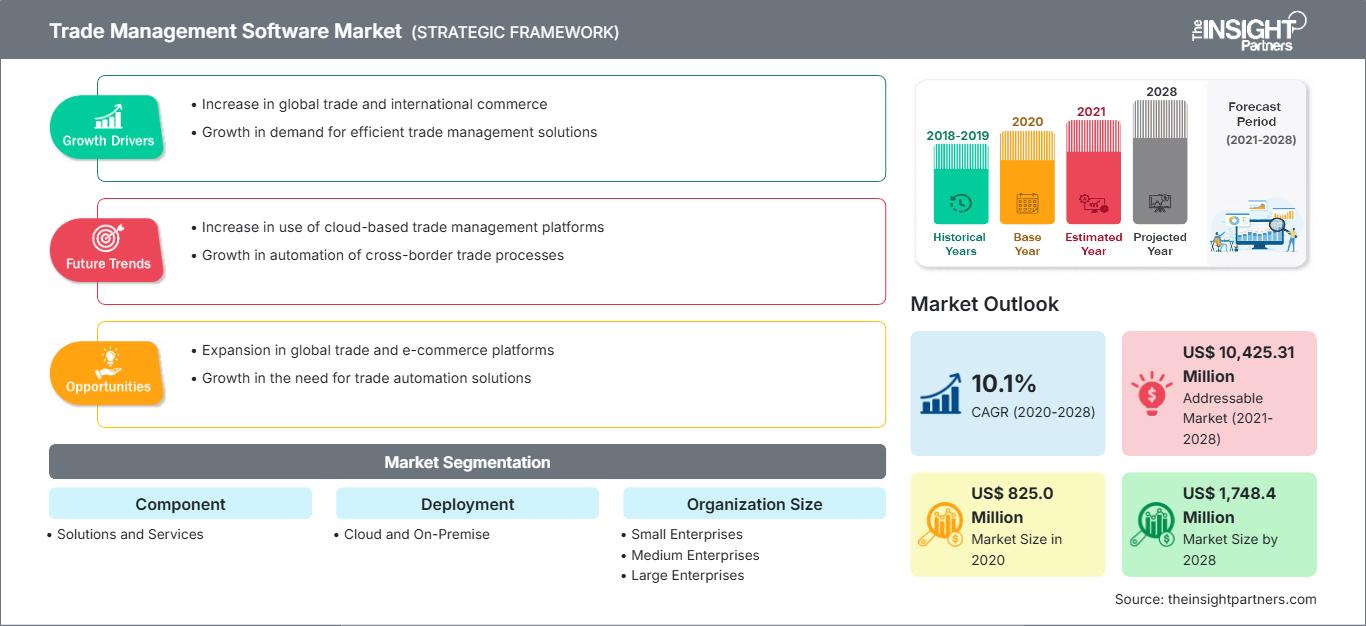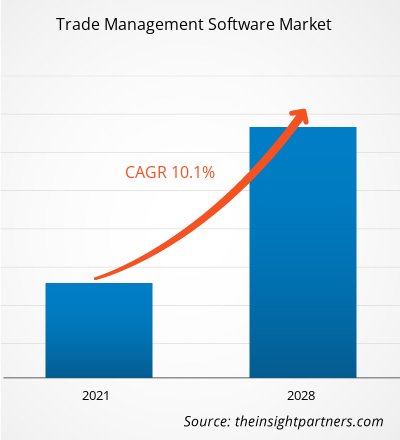[연구 보고서] 매출 기준으로 글로벌 무역 관리 소프트웨어 시장은 2020년 8억 2,500만 달러 규모였으며, 2028년에는 17억 4,840만 달러에 이를 것으로 예상됩니다. 2020년부터 2028년까지 연평균 성장률(CAGR) 10.1%로 성장할 것으로 예상됩니다.
무역 관리 소프트웨어 시장은 북미, 유럽, 아시아 태평양, 중동 및 아프리카, 동남아시아의 5개 주요 지역으로 크게 구분됩니다. 2020년에는 아시아 태평양 지역이 무역 관리 소프트웨어 시장을 주도했습니다. 아시아 태평양 지역은 각 제조 부문에서 높은 성장을 보이는 여러 개발도상국으로 구성되어 있으며, 글로벌 제조 허브로 자리매김했습니다. 중국을 비롯한 인도, 한국, 대만, 베트남과 같은 개발도상국들은 저숙련/중숙련 제조 시설을 노동력이 저렴한 인근 국가로 이전하려는 기업들을 유치하고 있습니다. 또한, 이들 국가 정부는 이 지역에 대한 외국인 투자를 확대하기 위한 노력을 기울이고 있습니다. 지난 몇 년간 이 지역의 제조업 지출은 크게 증가했으며, 앞으로도 상당한 성장률을 보일 것으로 예상됩니다. 제조업 지출의 급격한 증가와 신기술 도입은 이 지역의 무역 관리 소프트웨어 수요를 촉진하는 주요 요인입니다.
COVID-19 팬데믹이 무역 관리 소프트웨어 시장에 미치는 영향
COVID-19 팬데믹은 2019년 12월 이후 전 세계 모든 기업에 영향을 미쳤습니다. 바이러스 감염자 수가 지속적으로 증가함에 따라 정부는 사람과 상품의 운송을 제한해야 했습니다. 제조업은 일시적인 공장 폐쇄와 생산량 감소로 심각한 손실을 입었고, 이는 소매, 전자상거래, 물류 부문의 성장을 저해했습니다. 또한, 정부의 사회적 또는 물리적 거리두기 조치는 물류 및 기타 서비스 제공업체의 운영에 제약을 가했습니다. 이러한 혼란은 무역 사업의 감소로 이어졌습니다. 이러한 악재로 인해 2020년 5월 전 세계 무역량은 2019년 5월 대비 17.7% 감소했습니다. 2020년 첫 5개월 동안의 감소는 만연했지만, 특히 일본, 미국, 유럽 국가의 수출에 큰 영향을 미쳤습니다. 코로나19 팬데믹으로 인한 차질에도 불구하고, 기업들이 장기간의 봉쇄 이후 재개됨에 따라 향후 무역량은 급증할 것으로 예상됩니다. 사회적 거리두기 조치가 시행됨에 따라, 전자상거래, 물류, 소매 등 무역 활동에 참여하는 여러 부문은 공급망의 신속성을 확보하고 규정을 준수하기 위해 무역 관리 소프트웨어 도입에 집중하고 있습니다. 따라서 코로나19로 인한 불확실성은 물류 분야에서 클라우드 기반 소프트웨어/SaaS 활용 범위를 확대했습니다.
이 보고서의 일부, 국가 수준 분석, Excel 데이터 팩을 포함하여 모든 보고서에 대한 사용자 정의를 무료로 받을 수 있을 뿐만 아니라 스타트업 및 대학을 위한 훌륭한 제안 및 할인을 이용할 수 있습니다
무역 관리 소프트웨어 시장: 전략적 통찰력

-
이 보고서의 주요 주요 시장 동향을 확인하세요.이 무료 샘플에는 시장 동향부터 추정 및 예측에 이르기까지 데이터 분석이 포함됩니다.
무역은 공급업체, 운송업체, 창고 네트워크를 통해 여러 상품과 정보가 흐르는 복잡한 과정입니다. 소프트웨어 솔루션은 실시간 및 실제 데이터 분석을 통해 사용자가 이러한 복잡성을 더욱 정확하고 쉽게 처리할 수 있도록 지원하여 비효율성을 줄입니다. 이러한 소프트웨어 시스템을 구축하면 공급망 기능이 향상되고 운영에 대한 실시간 가시성이 제공됩니다. 다양한 산업의 경쟁력 강화는 자동화 및 디지털화에 대한 투자를 촉진하는 주요 요인입니다. 또한, 클라우드 기반 솔루션을 도입하면 수출 상품에 대한 실시간 가시성이 향상되고 운영 비용이 절감됩니다. 블록체인, 인공지능(AI), 물류 운영에 대한 예측 분석과 같은 신기술의 도입은 향후 몇 년간 글로벌 무역 관리 소프트웨어 시장 성장을 더욱 촉진할 것입니다.
구성 요소 세그먼트 분석
구성 요소를 기준으로 무역 관리 소프트웨어 시장은 솔루션과 서비스로 세분화됩니다. 솔루션 부문은 예측 기간 동안 글로벌 무역 관리 소프트웨어 시장을 선도할 것으로 예상됩니다. 솔루션 부문에는 무역 규정 준수, 국제 무역 가시성 및 실행이 포함됩니다. 또한, 국제 무역 가시성 및 실행 운영에는 국경 간 운송이 포함됩니다. 이러한 솔루션은 국제 무역 파트너 이벤트 및 프로세스에 대한 가시성을 제공합니다. 이러한 프로세스는 국제적이어야 하며 상업적 무역 파트너 간의 거래 및 계약을 포함해야 합니다.
구축 부문 분석
무역 관리 소프트웨어 시장은 구축 방식을 기준으로 온프레미스와 클라우드로 구분됩니다. 클라우드 부문은 예측 기간 동안 글로벌 무역 관리 소프트웨어 시장을 선도할 것으로 예상됩니다. 클라우드 구축은 중소기업에서 주로 채택하고 있습니다. 낮은 소유 비용, 유지 관리 및 업그레이드 비용 절감, 최신 기능 활용은 온프레미스 구축 대비 클라우드 구축의 주요 장점입니다.
조직 규모 부문 분석
조직 규모를 기준으로 무역 관리 소프트웨어 시장은 소기업, 중기업, 대기업으로 구분됩니다. 대기업 부문은 예측 기간 동안 글로벌 무역 관리 소프트웨어 시장을 선도할 것으로 예상됩니다. 전 세계적으로 여러 기업에서 효율성을 높이고 전체 운영 비용을 최소화하기 위한 무역 관리 소프트웨어에 대한 수요가 증가하고 있습니다. 대기업들은 적합한 공급망을 구축하고 전반적인 운영의 유연성을 확보하기 위해 이 소프트웨어를 도입하는 것이 일반적입니다.
산업 부문 분석
산업별로 볼 때, 물류 및 운송 부문은 예측 기간 동안 글로벌 무역 관리 소프트웨어 시장을 선도할 것으로 예상됩니다. 전통적인 방식을 넘어선 서비스를 제공하는 물류 제공업체에 대한 수요가 증가하고 있습니다. 경우에 따라 제3자 물류 제공업체는 파트너사의 해외 무역 구역을 운영하거나 관리합니다. 또한, 상품 생산 또는 조달과 관련된 창고 관리 및 부가가치 서비스를 제공하기도 합니다. 또한, 이들은 상품을 원산지에서 최종 사용자까지 효율적이고 경제적으로 운송하는 데 필수적인 모든 물류 및 운송 프로세스를 체계화합니다.
시장 참여자들은 경쟁사와의 경쟁을 위해 자사 제품에 첨단 기술과 기능을 통합하여 신제품 혁신과 개발에 집중하고 있습니다.
- 2021년 1월, SAP Hong Kong과 컨설팅 대기업 Deloitte는 국경 간 무역에 종사하는 기업에 상당한 혜택을 제공하기 위해 파트너십을 맺었습니다.
- 2019년 1월, Bamboo Rose는 구독 모델로 서비스를 출시했습니다. 이 모델은 고객이 더 나은 계획을 세우고, 혁신을 추진하고, 여러 기업으로 구성된 소매 커뮤니티와 협업하여 기술 투자 비용을 10~30% 절감할 수 있도록 지원합니다.
- 2019년 3월, Thomson Reuters는 글로벌 무역 관리(GTM) 소프트웨어 공급업체인 Integration Point를 비공개 금액으로 인수하여 북미 기반 수출입 고객층을 크게 확대했습니다.
무역 관리 소프트웨어 시장 지역별 통찰력
The Insight Partners의 분석가들은 예측 기간 동안 무역 관리 소프트웨어 시장에 영향을 미치는 지역별 동향과 요인들을 면밀히 분석했습니다. 이 섹션에서는 북미, 유럽, 아시아 태평양, 중동 및 아프리카, 그리고 중남미 지역의 무역 관리 소프트웨어 시장 부문 및 지역별 현황도 살펴봅니다.
무역 관리 소프트웨어 시장 보고서 범위
| 보고서 속성 | 세부 |
|---|---|
| 시장 규모 2020 | US$ 825.0 Million |
| 시장규모별 2028 | US$ 1,748.4 Million |
| 글로벌 CAGR (2020 - 2028) | 10.1% |
| 이전 데이터 | 2018-2019 |
| 예측 기간 | 2021-2028 |
| 다루는 세그먼트 |
By 구성 요소
|
| 포함된 지역 및 국가 |
북미
|
| 시장 선도 기업 및 주요 회사 프로필 |
|
무역 관리 소프트웨어 시장 참여자 밀도: 비즈니스 역학에 미치는 영향 이해
거래 관리 소프트웨어 시장은 소비자 선호도 변화, 기술 발전, 그리고 제품의 이점에 대한 인식 제고 등의 요인으로 인한 최종 사용자 수요 증가에 힘입어 빠르게 성장하고 있습니다. 수요가 증가함에 따라 기업들은 제품 및 서비스를 확장하고, 소비자 니즈를 충족하기 위한 혁신을 추진하며, 새로운 트렌드를 적극 활용하고 있으며, 이는 시장 성장을 더욱 가속화하고 있습니다.

- 을 얻으세요 무역 관리 소프트웨어 시장 주요 주요 플레이어 개요
- 솔루션
- 서비스
무역 관리 소프트웨어 시장 - 배포별
- 온프레미스
- 클라우드
무역 관리 소프트웨어 시장 - 조직 규모별
- 대기업
- 중기업
- 소기업
무역 관리 소프트웨어 시장 - 최종 사용자별
- 소매 및 CG
- 자동차
- 물류 및 운송
- 의료 및 제약
- 정부
- 항공우주 및 방위
- 화학 및 광물
- 제조
- 기타
무역 관리 소프트웨어 시장 – 지역별
-
북미
- 미국
- 캐나다
- 멕시코
-
유럽
- 프랑스
- 독일
- 이탈리아
- 영국
- 러시아
- 유럽의 나머지 지역
-
아시아 태평양(APAC)
- 중국
- 인도
- 한국
- 일본
- 호주
- APAC의 나머지 지역
-
중동 및 아프리카(MEA)
- 남아프리카
- 사우디아라비아
- UAE
- 나머지 MEA
-
남아메리카(SAM)
- 브라질
- 아르헨티나
- 나머지 SAM
무역 관리 소프트웨어 시장 – 회사 프로필
- Amber Road, Inc.
- Bamboo Rose LLC
- Expeditors International of Washington, Inc.
- Integration Point, LLC
- Livingston International
- MIC
- Oracle Corp
- QAD, Inc
- QuestaWeb
- SAP SE
- 과거 분석(2년), 기준 연도, CAGR을 포함한 예측(7년)
- PEST 및 SWOT 분석
- 시장 규모 가치/거래량 - 글로벌, 지역, 국가
- 산업 및 경쟁 환경
- Excel 데이터세트
최근 보고서
관련 보고서
사용 후기
구매 이유
- 정보에 기반한 의사 결정
- 시장 역학 이해
- 경쟁 분석
- 고객 인사이트
- 시장 예측
- 위험 완화
- 전략 기획
- 투자 타당성 분석
- 신흥 시장 파악
- 마케팅 전략 강화
- 운영 효율성 향상
- 규제 동향에 발맞춰 대응






















 무료 샘플 받기 - 무역 관리 소프트웨어 시장
무료 샘플 받기 - 무역 관리 소프트웨어 시장